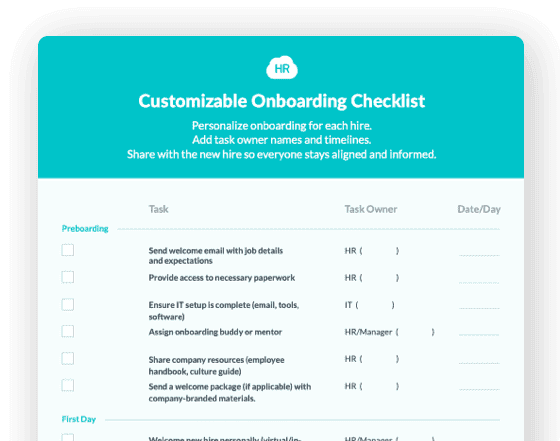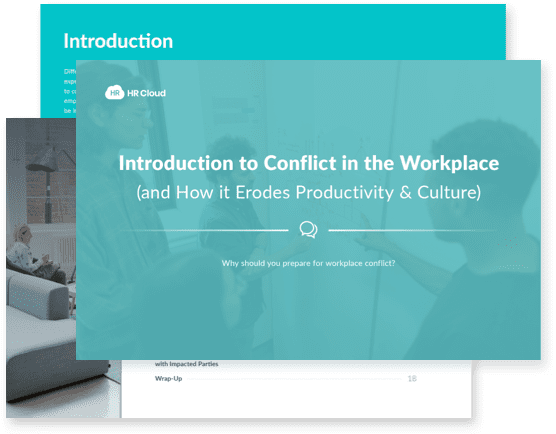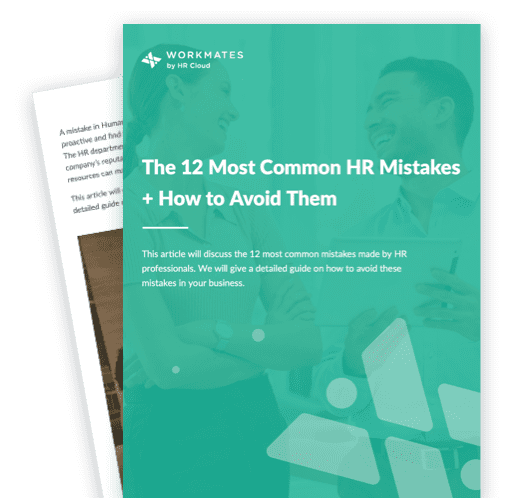5 Workplace Issues and How You Can Resolve Them



 Cut onboarding time
by 60%—here's the
Ultimate Checklist
that helped do it.
Cut onboarding time
by 60%—here's the
Ultimate Checklist
that helped do it.

From communication breakdowns and minor misunderstandings to differences in work styles and competing goals, workplace issues are as varied as the solutions to resolve them. But, if handled correctly, each situation offers a unique opportunity to improve your company’s workplace culture.
Understanding these issues and knowing how to navigate them can lead to improved teamwork, increased productivity, and a more positive work environment. By embracing issue resolution as a pivotal skill, leaders and employees alike can transform potential obstacles into stepping stones for organizational success.
Below, we’ll delve into five common types of workplace issues that arise in the workplace and provide actionable strategies for effectively addressing them.

1. Mental health
Mental health issues are increasingly common in the workplace, with at least 1 in 4 people experiencing mental health problems every year.
Employers may find it difficult to address mental illness, but the support you provide for mental health issues should be no less favorable than the resources you make available for physical ailments.
Most importantly, employers are under an obligation to take reasonable steps to support the well-being, health, and safety of their employees. This means that work practices and company culture should support good mental health and also employees with mental health problems. If an employee’s mental health illness is categorized as a disability, then they will also be protected against disability discrimination by the Equality Act 2010.
Employers do have the right to terminate an employee’s employment due to mental health illness. However, you must be able to show that you have taken all reasonable steps to resolve conflict and keep the employee in employment.
Short-term mental health issues
For employees suffering from short-term mental health problems, you would be advised to:
-
Give them opportunities to explain their absences
-
Explain to the employee how these absences could become an issue in future both for them as individual employees and for the business
-
Set a reasonable review period for monitoring their work performance and any absences related to their mental health issue(s)
Long-term mental health issues
Reasonable steps that you could take to support an employee who has a long-term mental health problem include:
-
Investigating the mental health condition, usually by asking for medical records, GP report, or occupational health report
-
Consulting the employee about how their condition affects their role
-
Exploring with them possible ways of overcoming any adverse impacts, such as adjusting their workload or changing their hours or the type of work
-
Making reasonable adjustments so that the employee can stay in their role
-
Anticipating your employee’s recovery and keeping the role open for them for as long as reasonably possible
2. Covid-19
The coronavirus has drawn attention to employees’ rights in an unprecedented way, particularly to the right to get paid according to their contract of employment, the right to health and safety at work, and much more.
With businesses being forced to close down and where it is not possible to work remotely, your employees are entitled to their contractual pay. The U.S. government Furlough Scheme (also known as the Coronavirus Job Retention Scheme) can help employers during this pandemic.
The financial support provided gives employers a percentage of their employees’ salaries, currently at 80% with a monthly cap of $3,000. But employees must agree to be put on the furlough scheme and, if you are not going to bridge the cap to cover 100% of their pay, accept only a percentage of their wage. So, discuss it with them first.
If employees believe there is an imminent danger in attending the workplace, such as contracting the coronavirus, they can also refuse to come to work. It can be unlawful for you to insist that they attend without first resolving the danger. This also applies to employees suspected of having or showing symptoms of the coronavirus (see S2(1) of the Health and Safety at Work Act 1974).
We strongly advise that you discuss any dangers with your employees and where possible try to let them work from home, especially where they are vulnerable.
Where an employee is pregnant, you are obliged to conduct a risk assessment and put her on suspension with full pay if necessary. If she is within 6 weeks of her due date, you can allow her to start maternity leave.
If you ask employees to work from home, they are entitled to their full contractual pay. However, if they are not attending the workplace due to coronavirus symptoms or being suspected of having the virus, they’re entitled to Statutory Sick Pay.

Introduction to Conflict in the Workplace
(and How it Erodes Productivity & Culture)
3. Bullying
Bullying at work is destructive behavior usually directed repeatedly at one individual or a small group. It can be vindictive, offensive, belittling, threatening, or a combination of behaviors. Some examples of bullying in the workplace are:
-
Persistent teasing or subjecting someone to frequent practical jokes
-
Constant criticism when it’s not justified
-
Verbal threats and verbal abuse designed to belittle, humiliate, or offend
-
Intentionally misleading someone about such things as deadlines or the nature of a task
-
Constant and unjustified monitoring of an individual’s performance
-
Turning down an individual’s requests for time off without good reason
Bullying can be carried out by an individual’s colleagues or by a manager. It has a demoralizing effect on the person or people being bullied and often adversely affects their performance as well as their mental health. It’s important to nip in the bud any reports of bullying and to deal promptly and thoroughly with any related complaints.
Most employers have policy guidelines for dealing with bullying, but in practice, they are not always used. If you do not adequately handle reported instances of bullying and complaints about it, a bullied employee could resign and potentially have a claim for unfair dismissal.
It is also implied in the employee’s contract of employment that you owe them a duty of trust and confidence and a duty to deal with complaints and grievances without undue delay. If you fail in these respects following a report or complaint of bullying, you could also end up facing claims of breach of contract.
Employees suffering from bullying could suffer mental injury and possibly physical injury. Where it can be medically proven that this was caused by the bullying and has led to financial loss due to being on sick leave, for example, they could have a claim for personal injury.
Employees who have been bullied in the workplace have many potential causes of action against employers who fail to address related complaints or to address them adequately. We advise you to have a legally sound policy in place and to ensure that it is implemented.
Each and every complaint needs to be investigated thoroughly and an open relationship maintained with your employees so that they feel comfortable with company culture and addressing issues like this with you.
4. Sexual Harassment
Sexual harassment has a broad definition in law, and there is much debate about the use of terminology to describe sexual harassment. However, it essentially refers to any behavior of a sexual nature that makes you feel intimidated, degraded, or humiliated or being obliged to work in an environment that gives rise to such feelings.
In practice, it can mean anything from unwanted jokes and comments of a sexual nature to displays of material of a sexual nature to sexual assault.
If an employee has been sexually assaulted, one of their first steps should be to report the incident to the police. However, in less serious cases, they’ll most likely raise the matter with you.
Your organization’s Equality and Diversity Policy should give guidance on how the complaint should be handled. Generally, you should take any complaint of sexual harassment very seriously, and investigate it promptly. Action should also be taken against the perpetrator in accordance with any disciplinary policy, with any defenses such as “it was just a joke,” being ruled unacceptable.
If you can show that you took all reasonable steps to prevent such harassment from occurring, you will have a better chance of defending a case of sexual harassment in an employment tribunal. Having said that, many employees who have faced sexual harassment at work would prefer not to go through the stress and delays of an employment tribunal case. They would prefer to negotiate a decent exit package in the form of a settlement agreement, leave their employment, and put the experience behind them.
Where you can show that you have adequately dealt with a complaint, the employee will have fewer grounds on which to negotiate compensation. However, if you haven’t handled it well, it will improve your employee’s negotiating position and probably end up costing your organization a great deal more by way of compensation, whether in an employment tribunal case or by way of a negotiated settlement.

HR mistakes impact your entire organization. Learn how to avoid the 12 most common mistakes with our free ebook.
Download now5. Redundancy
We are seeing an increasing number of redundancies during this pandemic. However, your employees’ rights remain as they were before.
When making between 20 to 99 employees redundant in any 90-day period, you are obliged to consult employees for a minimum of 30 days before any dismissals occur. Making 100 or more redundancies requires you to consult employees for at least 45 days.
There is no statutory consultation period for employers who make less than 20 redundancies. However, there is still a general obligation to consult. This means discussing the situation with employees, particularly those who are being selected for redundancy.
Redundancy is a large and complex legal topic, so the above is just an overview of the basics.
There are many legal pitfalls that an employer can easily fall into when carrying out redundancies but these are beyond the scope of a brief article such as this. We recommend that you have a look at Monaco Solicitor’s page on Redundancy for more.
Next Steps
At Monaco Solicitors, we would advise handling each of the workplace conflicts outlined above with great care.
Organizations with little recent experience in any of these scenarios would be well-advised to carry out further research so as to avoid the prospect of hefty compensation claims being made by employees who have done their homework and/or have legal representation.
Most importantly, remember your employees’ rights and start off by engaging in informal discussions. A formal route is not always the most effective in handling the personal circumstances that employees face in the workplace.
You never know, it may be that your employee merely wants an apology for bullying, wants to offer themselves redundancy to start a new career, or simply needs a supportive environment and company culture to help them cope better with their mental health issues.
Unlock a Bonus Strategy for a Better Workplace Environment
About Author:
Monaco Solicitors are a specialist employment law firm. We are based in London but handle cases for clients across the country. Because we only work in employment law, we are well placed to tackle some of the increasingly common workplace conflicts and to suggest how you might consider addressing them.
Keep Reading
45 Boss Day Messages That Actually Mean Something (2026 Guide)
When is Boss Day 2026? Mark your calendar for October 16, 2026 — the annual opportunity
Birthday Wishes for Coworkers: 50+ Messages That Build Workplace Connection
A coworker's birthday isn't just another calendar date—it's a meaningful opportunity to
Embracing Diversity: Recognizing Different Cultures in the Workplace
Workplaces today reflect the incredible diversity of the world around us. People bring
Like What You Hear?
We'd love to chat with you more about how HR Cloud® can support your business's HR needs. Book Your Free Demo

Build a Culture of Recognition. Boost Engagement. Guaranteed.
Workmates empowers employees to stay informed, connected, and appreciated—whether they’re on the front line, in the office, or remote. Recognition drives 12x higher engagement.Trusted by industry leaders in every sector




Cut Onboarding Costs by 60%.
Take the confusion and follow-ups out of onboarding with automated workflows, digital forms, and structured portals—so new hires ramp faster 3X quicker.Trusted by industry leaders in every sector





